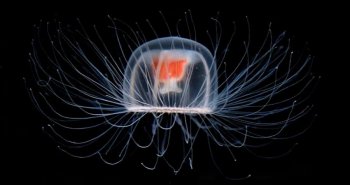Found in the waters of both the Mediterranean Sea and Japan, a tiny invertebrate called Turritopsis dohrnii is the only animal known to be biologically capable of reverting back to sexual immaturity after reaching adulthood. As there is no limit to the number of times it reverts back to a near-infant state, it can conceivably repeat the process forever, rendering it immortal.
Formerly known as Turritopsis nutricula, scientists first discovered the immortal jellyfish in 1883, when they found it swimming in the warm waters of the Mediterranean.
But it would take another century for scientists to discover the species’ unique abilities — and to discover that the immortal jellyfish’s long life wasn’t some otherworldly blessing, but an attempt to save itself from the dangers of the deep sea.
Taking cues from Mother Nature herself, the scientific community is looking to the Turritopsis dohrnii for new ways to manipulate cells.
In fact, one recent study of mice found success in using gene manipulation to get fibroblasts, a type of architectural cell in the heart, to transdifferentiate into cardiomyocyte-like cells, the essential bundles of muscle that allow the heart to do its job.
While researchers still have a long way to go in understanding just how the process which puts the “immortal” in “immortal jellyfish” can work to benefit humans, big strides are being made one step at a time.

This Jellyfish Can Live Forever: Here's How, And What This Means For Humans
Formerly known as Turritopsis nutricula, scientists first discovered the immortal jellyfish in 1883, when they found it swimming in the warm waters of the Mediterranean.
But it would take another century for scientists to discover the species’ unique abilities — and to discover that the immortal jellyfish’s long life wasn’t some otherworldly blessing, but an attempt to save itself from the dangers of the deep sea.
Taking cues from Mother Nature herself, the scientific community is looking to the Turritopsis dohrnii for new ways to manipulate cells.
In fact, one recent study of mice found success in using gene manipulation to get fibroblasts, a type of architectural cell in the heart, to transdifferentiate into cardiomyocyte-like cells, the essential bundles of muscle that allow the heart to do its job.
While researchers still have a long way to go in understanding just how the process which puts the “immortal” in “immortal jellyfish” can work to benefit humans, big strides are being made one step at a time.

This Jellyfish Can Live Forever: Here's How, And What This Means For Humans


 rophyll, high dose liposomal vitamin C, Vitamin D3 (and all the cofactors), full spectrum CBD oil with THC, B-17 which comes from apricot seeds .... frankincense and myrrh .....on and on.....
rophyll, high dose liposomal vitamin C, Vitamin D3 (and all the cofactors), full spectrum CBD oil with THC, B-17 which comes from apricot seeds .... frankincense and myrrh .....on and on.....